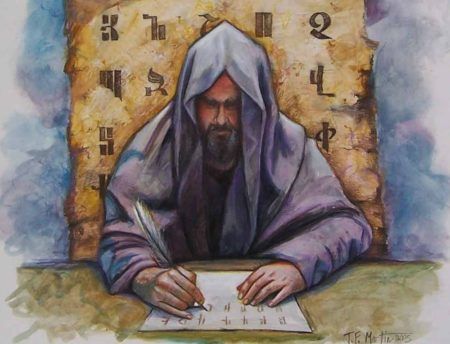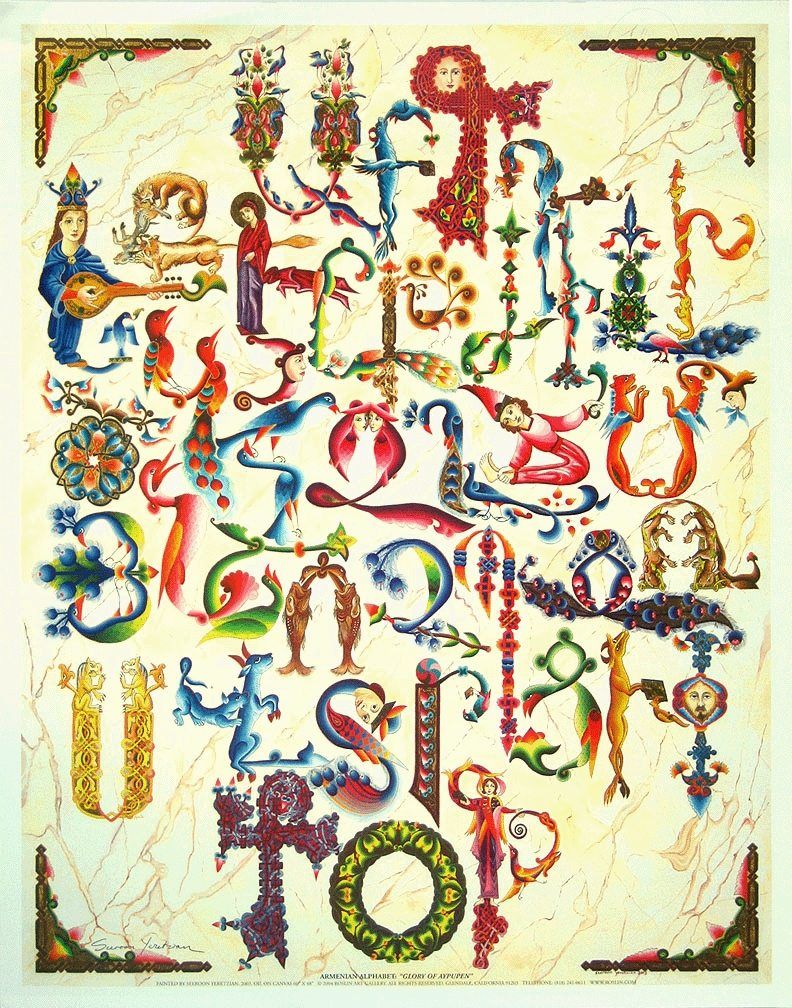Armenian is a very complex yet mysteriously beautiful language. Mesrop Mashtots created Armenian Alphabet in 405 AD in order to translate the Bible into Armenian. Thus, making it available for simple people.
Armenians sometimes refer to the 5th century as “the golden age of Armenia”. because the invention of the alphabet has hugely contributed to the development of Armenian written culture.
The Creation Of Armenian Alphabet
Mesrop Mashtots was born in 362 AD, in the village of Hatsekats, Armenia.
Sahak Partev, the Armenian catholicos, tasked Mashtots with creating a new Armenian alphabet.
Until that time, most written versions of Armenian were in Greek.
The alphabet begins with the letter A as Astvats (meaning God). and ends with Q as Qristos (meaning Christ). Later, however, three more letters appeared.
- և (yev). This is actually a conjunction which means ‘and”. It is used only in minuscule. Therefore when using capitals, it must be written like two letters- ԵՎ. On the beginning pronounced “yev”, in the middle of the word “ev”.
- Օ. Eastern Armenians use it at the beginning of the words when it should be pronounced as “o”, instead of “Ո”(vo). Western Armenians commonly use it in the middle of the words.
- The last one is ֆ (F).
Originally there were 36 letters in the Armenian alphabet. Three letters were added in the 10th-12th cc, for a total of 39 letters.
The original 36 letters of the alphabet were in 4 rows of 9 letters.
However, before Armenia adopted the Arabic numeral system, each letter represented a number.
The first row of letters was for the numbers 1-9, the second row for 10’s-90’s, the third row 100’s-900’s, and the fourth for 1000’s-9,000.
Hence, the letters in old Armenian represent 1996.
You will find this number system inscribed on old monuments in Armenia, as well as on a few modern ones (the Matenadaran for example).
In addition, the first sentence in Armenian using the alphabet is:
“Know wisdom and instruction; perceive the words of understanding.” (Mesrop Mashtots)
The Armenian Alphabet Before St. Mesrob: the Mystery of Bishop Daniel’s Script
from amaras
In 301 AD, the Kingdom of Armenia became the first state in the world that adopted Christianity as an official religion.
In 387 AD, however, Armenia entered a difficult period in its history. Armenia was losing its independence, as Persia and Byzantium conspired to divide the country. Christianity began declining in Persia-influenced part of Armenia. In many provinces, people revived pagan traditions.
At that time, Mesrob Mashtots held the position of secretary and interpreter at the royal court in the capital city of Vagharshapat. He received his primary education at a Greek school back home in Taron. He was also fluent in Greek, Persian, and Syriac.
St. Mesrob’s biographer Koryun described St. Mesrob as a valiant warrior and talented administrator. He earned respect at the court both for his good knowledge of martial arts and his personal skills.
Two concerns caused Mashtots’ initiative to create a separate alphabet for Armenians.
First, Armenians could not read the Holy Bible in Greek or Syriac. They could not understand sermons in those languages as well. This was a factor that accelerated the erosion of Christian faith in the countryside.
The second factor was a renewed threat of cultural assimilation due to the stronger role of Syrian clergy and pro-Persian feudal lords in Armenia. It was a kingdom whose independence was visibly eroding.
St. Mesrob grasped the full scope of these problems when, in around 395 AD, he temporarily left the royal court on an evangelizing mission to Armenia’s province of Syunik (today’s Armenia’s easternmost province) and the neighboring district of Goghtan (in present-day Nakhichevan, Azerbaijani Republic).
Upon his comeback to the capital city of Vagharshapat, Mesrob Mashtots met with Katholikos Sahak Partev (338 AD – 439 AD), the head of the Armenian Church, who offered St. Mesrob his full support.
Sahak Partev was from the family of St. Gregory the Enlightener, the founder of the Amaras Monastery. He is the co-author of the Armenian Alphabet. Similarly to St. Mesrop, the Armenian Church canonized Sahak Partev and Armenians often refer to him as Sahak the Great.
Armenian Church’s formal endorsement of Mashtots’ proposal at its synod coincided with King Vramshapuh’s return to the capital city from his trip to Mesopotamia. There the Armenian monarch tried to mediate a controversy connected with the exile of St. John Chrysostom by Aelia Eudoxia (died in 404 AD). the Empress consort of the Byzantine Emperor Arcadius.
Medieval authors report that while in Mesopotamia, King Vramshapuh found out about the existence of a certain old Armenian script, in possession of Bishop Daniel of Edessa. The king learned of the synod’s decision. Then, he dispatched his confidante Vahrich Khaduni to Mesopotamia to bring a sample of Daniel’s letters to the royal court for inspection by St. Mashtots and St. Sahak.
The origin of the Danielian script remains a matter of intense academic debate since no samples of it survived.
It is known — from Koryun and Movses Khorenatsi, and other authors as well — that the script had been adapted for Armenian. The arrangement of the letters was also according to the order of the Greek alphabet. The pattern that St. Mesrob used for all of the three alphabets he created.
The most common hypothesis about the source of the Danielian script suggests that it represented an earlier Armenian writing system. Semitic calligraphy was the base. It, however, was abandoned in ancient times due to its main shortcoming — inability to correctly reflect the phonetic structure of Armenian. Or, alternatively, it was forgotten due to the failure of the state to support its spread and popularization.
St. Mesrob’s disciple Koryun details that when the Danielian script arrived in Armenia, his tutor began using the letters without delay.
However, the inherent imperfections of the Danielian writing system rendered St. Mesrob’s teaching and translation efforts unproductive.
After two years of struggling with Bishop Daniel’s script, St. Mesrob left Armenia on his own trip to Mesopotamia. He then started seeking guidance from Greek and Syrian rhetoricians in the cities of Edessa and Samosata.
And it was in Samosata, in 406 AD, where, after many discussions and consultations with the top minds of his time, St. Mesrob came up with the final version of the Armenian Alphabet. Medieval historians never failed to depict this event as an expression of divine will.
Armenian Alphabet Monument
The Armenian Alphabet monument is dedicated to the creation of the alphabet by Mesrop Mashtots. It was built in 2005 on the eastern slope of Aragats mountain, in the village of Artashavan.
It consists of 39 stone carved statues of the Armenian letters. According to the plan of the famous architect Jim Torosyan, the monument was founded to commemorate the 1600th anniversary of the Armenian alphabet creation. It was also designed by him.
Besides the letters, there are also other sculptures in the Park. “Tumanyan with his heroes”, “Gregory the Illuminator”, “Creation of the letters, 405”, “Khachatur Abovyan” and “Mkhitar Gosh”.
If you go a little bit uphill from the monument, you will see the 33-meter high cross which symbolizes Jesus Christ’s age at the time he was crucified. It consists of 1711 big and small metal crosses that symbolize the age of the Christian Armenia.
ARMENIAN LANGUAGE
The Armenian language has three phases.
All of them are the result of the natural evolution of language.r:
First
Classical Armenian or “Grabar”. Armenians used it from 5th to 19th centuries.
It is the “language of books” (scholarly language in the Middle Ages) with borrowings from the Iranian languages. The Armenian Church still uses it.
This period was very rich in religious works. a great example is the translation of the Bible. It is called the “Queen of Translations” because of the beauty and perfection of the language. Also, due to its fidelity to the text.
Second
Middle Armenian. Used from 11th to 15th centuries.
It was the “language of the country” or “vulgar” language of common people. It gradually replaced the written form. Middle Armenian also became a literary language in the 19th century.
Third
Modern Armenian or “Ashkharabar” began in the 19h century. It has two branches:
- Eastern Armenian.
Spoken in Armenia, based on the dialect of Yerevan.
- Western Armenian
Spoken by the diaspora after the genocide of 1915, based on the dialect of Constantinople. Now western Armenians use it.
- Western Armenian Alphabet
- Easter Armenian Alphabet
Armenian forms an independent branch of the Indo-European language family. Armenian is most similar to Greek. It, however, has many borrowed words from such Indo-Iranian languages as Pushto and Persian. In fact, during the very early periods of its classification, people considered Armenian an Iranian language because of its large number of Iranian loan words.
Today about six million people speak Armenian, although the total population of the Republic of Armenia is only 3 million (94 % are ethnic Armenian). Thus, nearly half of Armenian speakers today live outside their historic homeland, mostly in Iran (370,000), Syria (299,000), Lebanon (235,000), Egypt (100,000), and the United States (175,000).
The creation of the Armenian alphabet was a very important event for Armenians. It was the key that allowed Armenians to preserve their culture and identity. Therefore, they had an exceptional longevity while others disappeared.












Leave a Comment